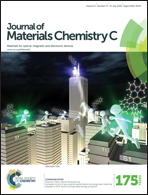Mo2C microspheres and nanorods as counter electrode catalysts for iodide-free redox couples in dye-sensitized solar cells†
Abstract
In this work, molybdenum carbide microspheres (Mo2C-Ms) and nanorods (Mo2C-Nr) are synthesized for use as counter electrode (CE) catalysts in dye-sensitized solar cells (DSSCs), specifically towards the regeneration of iodide-free redox couples of T2/T− and Co3+/2+. In the T2/T− based DSSCs, the prepared Mo2C-Ms and Mo2C-Nr both show high catalytic behavior, and the devices generate power conversion efficiency (PCE) values of 5.50% (Mo2C-Ms) and 4.86% (Mo2C-Nr), respectively, much higher than the Pt CE based counterpart (3.73%). Electrochemical impedance spectroscopy, cyclic voltammetry, and Tafel polarization curve measurements reveal that Mo2C-Ms also show higher catalytic activity for the Co3+/2+ redox couple that is competitive with the traditional Pt CE. The device using a Mo2C-Ms CE achieves a high PCE of 8.70%, indicating great potential to replace the expensive Pt CE.


 Please wait while we load your content...
Please wait while we load your content...